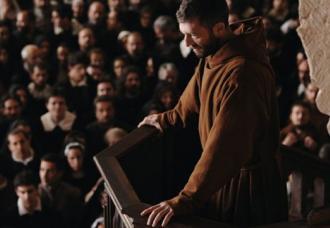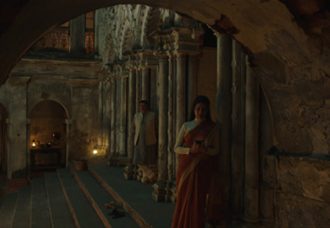Melancholia
Lars von Trier has zeroed in on Andrei Tarkovsky as the greatest filmmaker of all times and, judging from his pronouncements, he is regarding himself as Tarkovsky’s successor. Tarkovsky was a great filmmaker but if Lars von Trier’s Melancholia bears a resemblance to any of Tarkovsky’s works, it is to The Sacrifice, the Russian director’s most doubtful effort and, if anything, an exercise in megalomania.
For reasons that are difficult to determine, there has emerged a school of filmmaking in the past few decades in which the filmmaker assumes the air of a prophet – it perhaps began with Ingmar Bergman but is more exemplified by the later Tarkovsky (Nostalgia and The Sacrifice), Theo Angelopoulos and now Lars von Trier. Writers and artists do not seem to regard themselves as seriously as filmmakers here because few of them seem to make claims to such importance. But with due deference to all filmmakers, although, with some expenditure, cinema can put together a world very convincingly, it is difficult to think that the future of the world is in their hands. The reader may find this remark rather provocative but I imagine that it will make a work of cinema more contemporary if it betrays some skepticism about its ultimate importance in the scheme of the world. There is also something fairly ludicrous in a ‘work of prophecy’ vying for the top award at Cannes.
Melancholia (2011) begins with an ‘Overture’ shot in extreme slow motion, involving the main characters and images from space. A shot from a vantage point in space shows a smaller planet approaching Earth; the two planets collide. This is an extraordinarily beautiful sequence but by the end of the film we have begun to wonder whose viewpoint this might represent – that of a prophet with a ringside view of the destruction of mankind? If this sounds facetious, taking a viewpoint outside Man may be fine for genre cinema like SF but not appropriate for ‘visionary art’; any vision of Man perhaps needs to be earthbound.
Melancholia continues, in two parts, each named for one of the two sisters. In part one, ‘Justine’, the young couple, Justine (Kirsten Dunst) and Michael are at a wedding reception at the mansion of Justine’s sister, Claire (Charlotte Gainsbourg), and her husband John (Kiefer Sutherland). The film ventures into Ingmar Bergman territory here because there is ugly family strife: Justine’s divorced, bitter mother makes sarcastic and insulting remarks, ultimately resulting in John attempting to evict her from his property. Since Justine works in the advertising industry her boss follows her around, begging her to write a piece of advertising copy. On several occasions she looks at a particular red star, which seems to shine brighter than normal. Claire’s husband John says it is the star Antares but, later in the film, the star disappears. Justine gradually drifts away from the party and becomes increasingly distant during the night. She has sex with a stranger on the lawn.
In part two, ‘Claire’, Justine has become severely depressed. She has come to stay with Claire and John, who live with their son Leo in the mansion where the party took place. Michael is not with her but we don’t know if it is on account of her infidelity. John explains that the reason for Antares’ disappearance was the rogue planet Melancholia, which had eclipsed the star. Melancholia, which had been hidden behind the sun, becomes visible in the sky, approaching Earth. John, who is an amateur astronomer, is excited about the planet, and looks forward to the spectacle expected by scientists, who have assured the public that Earth and Melancholia will pass by each other without colliding.
As days extend into weeks and months it becomes evident that Melacholia will not pass by but will collide with the Earth. Claire does a search on the internet and finds a site describing the movements of the planet Melancholia around Earth as a ‘dance of death’ in which the apparent passage of Melancholia initiates a slingshot orbit that will bring the planets into collision soon after. On the night of the predicted fly-by, it seems that Melancholia will not hit Earth but the relief is proved short-lived. John, who understands that the end is near, commits suicide. His body is found by Claire, who decides to conceal it from Leo and Justine. Justine, Claire and Leo enter a shelter they have erected as the planet approaches. Claire continues to remain agitated and fearful, while Justine and Leo remain calm and hold hands.
Melancholia exudes self-importance and almost makes us catch our breath although we are never sure of its purport. If the film is about people trapped in private despair, what can a planet’s collision with the Earth have to do with it? To claim that the film examines the human psyche in a disaster, the characters conduct themselves virtually in the same way in both parts although the disaster is not imminent in the first one. Melancholia seems to be located in a grey zone outside both psychology and physics – which is not to suggest that it has anything to do with metaphysics. If the film has gravity and is sumptuously mounted, we are less than convinced that it is intelligent. Lars von Trier creates a hermetic world in which nothing from the outside intrudes but given the extreme circumstances he posits – the imminent destruction of mankind – we may be certain that actual world would have intruded. If the destruction of the planet were imminent, there would be so much chaos that people would find it difficult to experience private despair.
I compared the film to Tarkovsky’s The Sacrifice but that film was about a man-made calamity and there was some justification in blurring the lines between the inner and the outer worlds but this excuse is not available to Melancholia – which is about a celestial phenomenon. It is perhaps because Melancholia’s implications are so indeterminate that critics have responded to the cultural references in it piecemeal. Manohla Dargis (in The New York Times) lists the following references in the Overture: Wagner’s opera Tristan and Isolde, Marquis de Sade’s Justine, Alain Resnais’ film Last year at Marienbad, Hunters in the Snow, a painting by Pieter Brueghel, Andrei Tarkovsky’s Solaris (which also invokes Brueghel’s painting), the Old Testament (Isaiah 51:8), DeMille’s The Ten Commandments and Shakespeare’s Hamlet. While one is impressed by the range of Lars von Trier’s erudition, one is still left wondering if identifying these as evidence of the film’s worth is not comparable to judging a dish by the cost of the ingredients going into it. One would not, for instance, expect an Indian filmgoer to be excited by the information that Hum Aapke Hain Koun…! invokes Tulsidas’ Ramcharitamanas and the Bhagwad Gita or that the song Didi Tera Dewar Deewana in the film is set to Raag Darbari Kanada.
My own inclination is also to look at the film piecemeal but not at what Von Trier would like us to consider. The special effects in the film are sometimes staggering – especially the final approach of the planet towards the Earth but this only provides evidence the kind of technicians Von Trier has employed. The mansion in which the story is set is magnificent if one was looking at property to acquire but it becomes tedious as the setting for the film because there is so little of anything else. The casting in the film is eccentric, to say the least. If John Hurt and Kiefer Sutherland are difficult to see in the same family, casting Kirsten Dunst and Charlotte Gainsbourg as sisters has perhaps only been exceeded by Arnold Schwarzenegger and Danny DeVito as twins but Melancholia is hardly intended as low comedy. Kirsten Dunst received the Best Actress Award at Cannes in 2011 but Spider-Man is still the highpoint of her career. Spider-Man required her to show love for a man who had been bitten by a genetically modified spider and spent his hours crawling up walls while Melancholia only requires her only to wait for the end of the world.
<The above review originally appeared in Bikas Mishra‘s film publication, ‘Dear Cinema’>
IMDB link of Lars von Trier’s Melancholia (2011)








